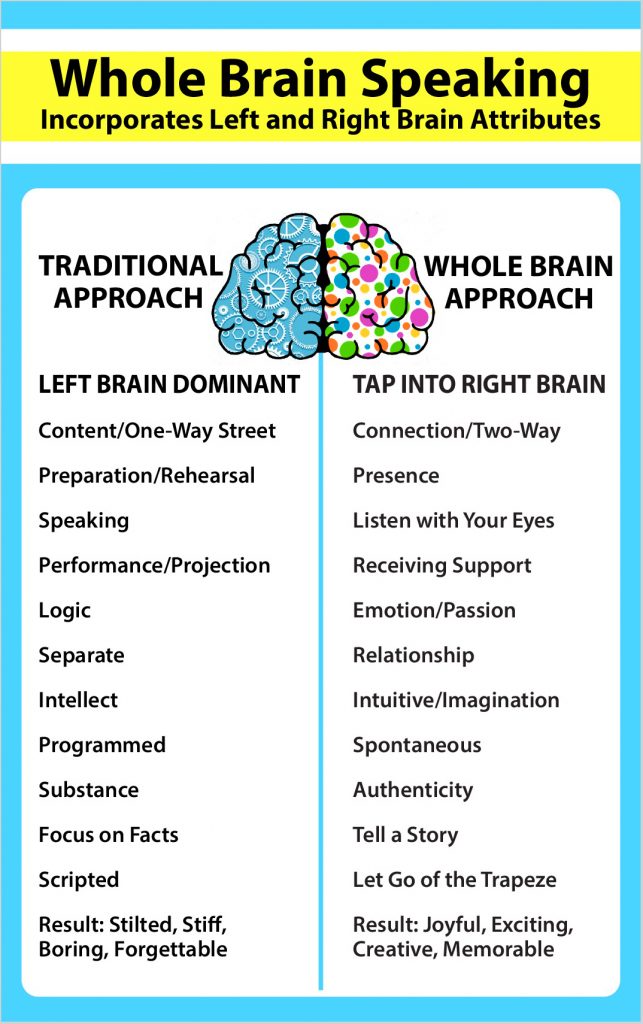If you want to become a more comfortable, compelling, and charismatic speaker, you should learn about the secrets of what I call Whole Brain Speaking.
This involves balancing elements of both the Left Brain and the Right Brain in every presentation. Striking the right balance is key to speaking success.
The most successful speakers master a well-balanced combination of being present in the moment with high-level preparation and performance skills. Put simply, successful speakers find ways to pack authentic presence into every presentation.
Every speech or presentation is a real-time relationship between speaker and audience. This is true whether you’re speaking on stage in a crowded ballroom or online in a Zoom-assisted webinar. As a speaker, you show that you value the relationship by being prepared, but not overly programmed.
Yes, it’s essential to prepare, to organize your material effectively, and to rehearse. It’s not a good idea to simply go out on stage and “wing it” every time. You don’t want to just say the first thing that pops into your head. That’s not what being present in the moment means. That’s not what authentic speaking and connecting with the audience are all about.
[headline type=”h3″ title=”Combine Left and Right Brain Attributes”]
As you’ll see in the chart below, preparation, performance, and rehearsal are classic Left Brain functions. Presence, connection, and authenticity reside on the right side of the brain.
In this chart, the column on the left summarizes the traditional Left Brain approach to “public” speaking. These qualities are important to any successful presentation, but total reliance on them will produce an unsatisfactory experience for both the speaker and the audience. Depending too much on these Left Brain qualities turns speeches and presentations into nothing more than boring, stale, uninspiring data dumps.
My revolutionary Whole Brain Speaking approach is more holistic, interactive, and relational. The idea is to take the Left Brain qualities as the bare essentials and then go the extra mile by tapping into the Right Brain.
Whole Brain Speaking is the Value Added approach to speaking. The qualities in the left column get you part of the way there. To really wow your audiences, however, you need to add the Right Brain attributes. The goal is to transform a merely competent, informative speech into something truly moving and memorable.
Let me be clear. I am using the terms “left brain” and “right brain” based loosely on how they have been understood in the popular culture. I’m not a psychologist or brain scientist, nor do I play one on TV. I hope you’ll grant me some poetic license in adapting these brain-related concepts to the domain of speaking.
Many decades ago, there was a character on television named Joe Friday, a detective with the Los Angeles Police Department (Google Dragnet). It’s safe to say that Joe would make a very dry speaker. His left brain-dominant, “Just the facts, ma’am,” approach might be great for a detective investigating a crime, but it would bomb on the podium.
An effective, authentic, joyful speaker needs to go beyond “Just the facts, ma’am.” Speakers should go beyond the content and touch the heart, tap into the imagination and the dreams of the audience. And that means occasionally speaking from, and appealing to, the right side of the brain.
The best way to use the accompanying chart is to pick any quality on the left side of the page and then consider ways to also incorporate the corresponding right brain quality on the right side. For example, once you’ve developed, rehearsed, and mastered the content of your speech, give some attention to connecting with the audience.
Similarly, now that you’ve prepared your remarks, remind yourself to be present in the moment. While speaking to the audience, remember to also listen—with your ears and your eyes. Practice the art of hearing with your eyes, as Shakespeare refers to it in Sonnet 23.
Don’t just project outward. Remember to receive the audience (especially the support from the audience). Don’t rely on logic and facts alone. Include an appeal to passion, emotion, and imagination. Tapping into the right brain really brings your presentation to life. It allows you to move an audience emotionally. English poet, critic, and philosopher, Samuel Coleridge, said it well: “What comes from the heart goes to the heart.” John Ford, the legendary film director, made a similar observation: “You can speak well if your tongue can deliver the message of your heart.” Powerful words to live by for any speaker.
[headline type=”h3″ title=”Let Go of the Trapeze”]

If you watch trapeze artists at the circus, the real excitement begins when they let go of the trapeze bar. There isn’t much interest in watching someone swing back and forth hanging from a trapeze bar. The magic happens between the bars.
For speakers, being too scripted and programmed, anchoring your talk in Left Brain attributes, is essentially the same as clinging to the trapeze bar and just swinging back and forth. You – and your audiences – deserve more than that. That way boredom lies.
Don’t be overly programmed. Demonstrate some degree of spontaneity. Tell a personal story. Bring along your personality and let it shine. Make sure the real you shows up. Let go of the trapeze once in awhile. Mix healthy doses of authenticity with your great, finely honed substance. Turn your talk into a two-way relationship instead of simply a one-way information transfer.
The right brain relishes stories, especially heartfelt, revealing, personal stories. Remember that the audience—comprised of individual human beings—is listening and
responding with the whole brain, not just the left brain. This is where you can be spontaneous and improvisational. It’s where you can let go of the trapeze. And like trapeze artists, speakers should soar, not bore.
A great example of letting go of the trapeze is Martin Luther King’s historic “I Have a Dream” speech. The most memorable lines were not scripted. He had spoken about his dream on several occasions before, but on that hot August day in 1963, in the shadow of the Lincoln Memorial, he launched into the famous dream sequence about midway into his prepared speech after being prompted by singer Mahalia Jackson, who was standing nearby. “Tell them about the dream, Martin,” she urged. He let go of the trapeze and soared off-script into the realm of a powerful dream—into the right brain—that changed hearts and minds and ultimately transformed our country and the world.
The right brain is where the magic is. It’s also where joy resides. So, when you speak, venture into the right side of the brain once in a while. You’ll have much more fun, and so will the audience. You’ll also increase your impact.
In short, study the right-hand column carefully and incorporate many of these elements into your next speech or presentation. If you routinely feature this Value Added approach in your presentations, you will find yourself enjoying the experience much more—and so will your audience.
Remember this: Audience members bring their whole brains – both the Left and the Right Brain – when they attend your presentations. And their Right Brains crave some attention. As a speaker, you should give it to them by using your whole brain. Let go of the trapeze. Pack more of your personal presence into your presentation.
The result of a Left Brain only approach is predictable: A stilted, stiff, boring, forgettable presentation. If you tap into the Right Brain, your presentations will be more joyful, exciting, creative, and memorable.
The choice is yours.
[headline type=”h3″ title=”About Matthew Cossolotto”]
A former NATO speechwriter, Matthew Cossolotto (aka The Podium Pro) is the author of the recently released The Joy of Public Speaking (available on Amazon.com books). Matthew conducts public speaking workshops and other Personal Empowerment Programs (PEPTalks). For more information, visit www.ThePodiumPro.com.
[headline type=”h2″ title=”More Excellent Books About Public Speaking”]
[catablog template=”archive” navigation=”disable” category=”David Portney”]

